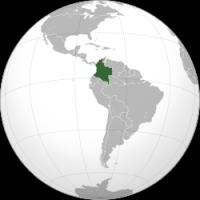|
|
|
Colombia, officially the Republic of Colombia ( ), is a unitary constitutional republic comprising thirty-two departments. The country is situated mostly in the Northern Hemisphere where its thirty-one contiguous departments and Bogotá, D.C., the capital district; bordered by Venezuela at east and Brazil; to the south by Ecuador and Peru; to the north by the Caribbean Sea; to the northwest by Panama; and to the west by the Pacific Ocean. Colombia also shares maritime borders with Venezuela, Jamaica, Haiti, the Dominican Republic, Honduras, Nicaragua and Costa Rica.. Colombia is the only South American country with coasts on the Pacific Ocean and Caribbean Sea, where has several islands and the archipelago of San Andres and Providencia. Is recognized worldwide for the production of palm oil, mild coffee, flowers, emeralds, coal, oil and its cultural diversity. Between 1980 and 1996, Colombia was considered the largest producer of cocaine in the world, but thanks to the reform efforts of recent times, the estate tax and Plan Colombia led by the United States, the landscape has changed significantly. At 440,831 square miles (1.14 million km2) and with over 46 million people, Colombia is the twenty-sixth largest country by total area, and the twenty-seventh largest by population, and the second largest in South America, after Brazil. Colombia has the third largest population of any Spanish-speaking country in the world, after Mexico and Spain. It is one of the world's most ethnically diverse and multicultural nations. The Colombian economy is the fourth South American largest national economy, with an estimated 2010 GDP of $435.367 Billion. The territory of what is now Colombia was originally inhabited by indigenous people including the Muisca, Quimbaya, and Tairona. The Spanish arrived in 1499 and initiated a period of conquest and colonization creating the Viceroyalty of Peru, and then in 1717 the Viceroyalty of New Granada (comprising modern-day Colombia, Venezuela, Ecuador, north-western Brazil and Panama), with its capital in Bogotá. Independence from Spain was won in 1819 by Simón Bolívar, but by 1830 "Gran Colombia" had collapsed with the secession of Venezuela and Ecuador. What is now Colombia and Panama emerged as the Republic of New Granada. The new nation experimented with federalism as the Granadine Confederation (1858), and then the United States of Colombia (1863), before the Republic of Colombia was finally declared in 1886. Panama seceded in 1903. Colombia was the first constitutional government in South America, and the Liberal and Conservative parties, founded in 1848 and 1849 respectively, are two of the oldest surviving political parties in the Americas. However, tensions between the two have frequently erupted into violence, most notably in the Thousand Days War (1899 � 1902) and La Violencia, beginning in 1948. Since the 1960s, government forces, left-wing insurgents and right-wing paramilitaries have been engaged in the continent's longest-running armed conflict. Since 2000 the violence has decreased significantly, with many paramilitary groups demobilising as part of a controversial peace process and the guerrillas losing control of much of the territory they once dominated. Meanwhile Colombia's homicide rate almost halved between 2002 and 2006. Nevertheless, 2010 saw an increase in the homicide rate compared to 2008, rising from 34 murders per 100,000 citizens to 39 in 2010. According to the Maplecroft research institute, in 2010 Colombia still had the world's sixth highest risk of terrorism. Colombia is a standing middle power with the fourth largest economy in Latin America. However income and wealth are unevenly distributed. In 1990, the income ratio between the richest and poorest 10% was 40-to-one, climbing to 80-to-one in 2000. In 2009, Colombia had a Gini coefficient of 0.587, one of the highest in Latin America, with 46% of Colombians living below the poverty line and 17% in "extreme poverty". Colombia is very ethnically diverse, and the interaction between descendants of the original native inhabitants, Spanish colonists, Africans brought as slaves and twentieth-century immigrants from Europe and the Middle East has produced a rich cultural heritage. This has also been influenced by Colombia's varied geography. The majority of the urban centres are located in the highlands of the Andes mountains, but Colombian territory also encompasses Amazon rainforest, tropical grassland and both Caribbean and Pacific coastlines. Ecologically, Colombia is one of the world's 17 megadiverse countries, and is considered the most megadiverse per square kilometer. |




 RSS
RSS